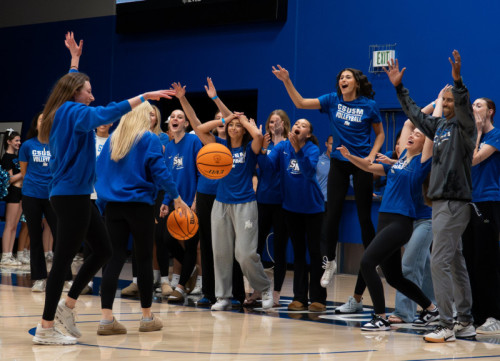 Photo Highlights From Cougar MadnessCal State San Marcos students filled The Sports Center on Oct. 15 for Cougar Madness, the university's annual event celebrating the beginning of the college basketball season. The men's basketball team opens the regular season by hosting Concordia University on Nov. 14. The women's team also opens Nov. 14 with a home game against Azusa Pacific. Visit the athletics website for complete schedules for both teams. Relive some of the event highlights in the Cougar Madness photo slideshow. Media Contact Eric Breier, Interim Assistant Director of Editorial and External Affairs ebreier@csusm.edu | Office: 760-750-7314
Photo Highlights From Cougar MadnessCal State San Marcos students filled The Sports Center on Oct. 15 for Cougar Madness, the university's annual event celebrating the beginning of the college basketball season. The men's basketball team opens the regular season by hosting Concordia University on Nov. 14. The women's team also opens Nov. 14 with a home game against Azusa Pacific. Visit the athletics website for complete schedules for both teams. Relive some of the event highlights in the Cougar Madness photo slideshow. Media Contact Eric Breier, Interim Assistant Director of Editorial and External Affairs ebreier@csusm.edu | Office: 760-750-7314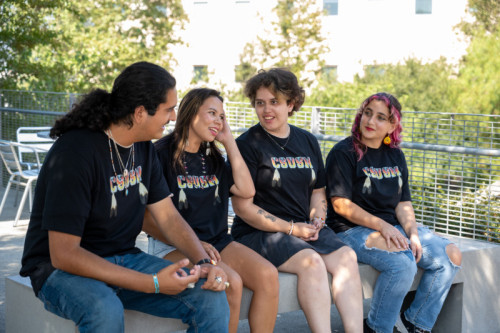 Celebrating Native American Heritage MonthThroughout November, Cal State San Marcos will be celebrating and recognizing the contributions of American Indians with a series of special events as part of Native American Heritage Month. CSUSM invites all members of the campus community to participate in the following events. Pow Wow Dance Workshops Tuesday, Nov. 4, 11, 18, 6-8 p.m., Serenity Circle Learn the history, meaning and movement of pow wow dancing in this interactive workshop led by Kiara Flores. Celebrate culture, community and tradition through dance. Chow on Deck: United in Service – A Celebration of Native American Veterans Tuesday, Nov. 4, noon, Epstein Family Veterans Center deck American Indian Student Center NAHM Kickoff Event Friday, Nov. 7, 5-8 p.m., USU Amphitheater CSUSM’s American Indian Student Center invites the campus community to celebrate the start of Native American Heritage Month. The evening will include traditional bird singing, pow wow dancing and storytelling along with food prepared by Chef Carmen of Island Smoke N’ Grill. CSUSM Second Annual Social Gathering Thursday, Nov. 20, 3-6:30 p.m., Mangrum Track & Field The event will feature traditional bird singers and dancers, along with local vendors showcasing Native art and jewelry. All are welcome to join in this celebration of community and culture. Note: Due to extenuating circumstances, the social gathering will not be held as scheduled on Nov. 20. It will be postponed until the spring or summer of 2026. For inquiries, you can email communityengagement@csusm.edu. Media Contact Eric Breier, Interim Assistant Director of Editorial and External Affairs ebreier@csusm.edu | Office: 760-750-7314
Celebrating Native American Heritage MonthThroughout November, Cal State San Marcos will be celebrating and recognizing the contributions of American Indians with a series of special events as part of Native American Heritage Month. CSUSM invites all members of the campus community to participate in the following events. Pow Wow Dance Workshops Tuesday, Nov. 4, 11, 18, 6-8 p.m., Serenity Circle Learn the history, meaning and movement of pow wow dancing in this interactive workshop led by Kiara Flores. Celebrate culture, community and tradition through dance. Chow on Deck: United in Service – A Celebration of Native American Veterans Tuesday, Nov. 4, noon, Epstein Family Veterans Center deck American Indian Student Center NAHM Kickoff Event Friday, Nov. 7, 5-8 p.m., USU Amphitheater CSUSM’s American Indian Student Center invites the campus community to celebrate the start of Native American Heritage Month. The evening will include traditional bird singing, pow wow dancing and storytelling along with food prepared by Chef Carmen of Island Smoke N’ Grill. CSUSM Second Annual Social Gathering Thursday, Nov. 20, 3-6:30 p.m., Mangrum Track & Field The event will feature traditional bird singers and dancers, along with local vendors showcasing Native art and jewelry. All are welcome to join in this celebration of community and culture. Note: Due to extenuating circumstances, the social gathering will not be held as scheduled on Nov. 20. It will be postponed until the spring or summer of 2026. For inquiries, you can email communityengagement@csusm.edu. Media Contact Eric Breier, Interim Assistant Director of Editorial and External Affairs ebreier@csusm.edu | Office: 760-750-7314
- Photo Highlights From Cougar MadnessCal State San Marcos students filled The Sports Center on Oct. 15 for Cougar Madness, the university's annual event celebrating the beginning of the college basketball season. The men's basketball team opens the regular season by hosting Concordia University on Nov. 14. The women's team also opens Nov. 14 with a home game against Azusa Pacific. Visit the athletics website for complete schedules for both teams. Relive some of the event highlights in the Cougar Madness photo slideshow. Media Contact Eric Breier, Interim Assistant Director of Editorial and External Affairs ebreier@csusm.edu | Office: 760-750-7314

- Celebrating Native American Heritage MonthThroughout November, Cal State San Marcos will be celebrating and recognizing the contributions of American Indians with a series of special events as part of Native American Heritage Month. CSUSM invites all members of the campus community to participate in the following events. Pow Wow Dance Workshops Tuesday, Nov. 4, 11, 18, 6-8 p.m., Serenity Circle Learn the history, meaning and movement of pow wow dancing in this interactive workshop led by Kiara Flores. Celebrate culture, community and tradition through dance. Chow on Deck: United in Service – A Celebration of Native American Veterans Tuesday, Nov. 4, noon, Epstein Family Veterans Center deck American Indian Student Center NAHM Kickoff Event Friday, Nov. 7, 5-8 p.m., USU Amphitheater CSUSM’s American Indian Student Center invites the campus community to celebrate the start of Native American Heritage Month. The evening will include traditional bird singing, pow wow dancing and storytelling along with food prepared by Chef Carmen of Island Smoke N’ Grill. CSUSM Second Annual Social Gathering Thursday, Nov. 20, 3-6:30 p.m., Mangrum Track & Field The event will feature traditional bird singers and dancers, along with local vendors showcasing Native art and jewelry. All are welcome to join in this celebration of community and culture. Note: Due to extenuating circumstances, the social gathering will not be held as scheduled on Nov. 20. It will be postponed until the spring or summer of 2026. For inquiries, you can email communityengagement@csusm.edu. Media Contact Eric Breier, Interim Assistant Director of Editorial and External Affairs ebreier@csusm.edu | Office: 760-750-7314

- Alumna Finds Purpose in Advocacy for Native Children and FamiliesAs Maya Goodblanket reflects on her time as a student, she vividly remembers the day she found the California Indian Culture and Sovereignty Center at Cal State San Marcos. Goodblanket was nervous about checking out the CICSC. She didn’t know anyone on campus and was unsure about going inside. But she mustered the courage to open the door, and all of her anxiety disappeared as she was instantly welcomed. Little did she know that she was meeting mentors that day who would help her achieve the career she has today. Through intentional support from faculty and staff and inclusive spaces like the CICSC, CSUSM equips students to lead with identity, purpose and impact. “I was looking for that connection to my culture, and I found it on campus,” said Goodblanket, who received a bachelor’s degree in psychological science and a Master of Social Work at CSUSM. “I'm an out-of-state Native. My tribe is from Oklahoma, so I always am searching to reconnect with tribal communities and tribal culture.” Goodblanket, a member of the Cheyenne and Arapaho Tribes of Oklahoma, serves as an Indian Child Welfare Act (ICWA) court advocate for the Valley Center-based Indian Health Council, which provides health and wellness services for American Indian communities in north San Diego County. Any families involved in a child welfare case, such as a juvenile dependency proceeding, can rely on Goodblanket for support. "I work with moms and dads who are struggling with a variety of challenges," Goodblanket said. "One is substance abuse. My job is to support families in doing what they need to do to reunite with their kids if they’re not currently in a place to have them back. I also work with caregivers and family members who have taken placement of the children." Goodblanket’s cultural connection is at the heart of her advocacy. Under the ICWA, child welfare agencies must prioritize placing American Indian children with relatives or within their tribal communities whenever possible. “Natives are still removed at a disproportionate rate by child welfare services,” Goodblanket said. "When children are disconnected from their culture, their long-term outcomes aren't as strong as those who remain connected. That’s why the cultural component is such a vital part of the work I do." As a student, Goodblanket participated in CSUSM’s inaugural “Beyond the Stereotype" campaign to raise awareness about cultural appropriation and the harm caused by stereotypes. Goodblanket and other students were featured on posters across campus that challenged common misconceptions about underrepresented groups. She emphasized the need to raise awareness about issues like missing and murdered Indigenous women and the harmful sexualization of Native women through stereotypes and costumes, which contribute to broader societal perceptions and injustice. "Maya demonstrates how education driven by purpose and cultural knowledge creates lasting change,” said Joely Proudfit, chair of the American Indian studies department and director of the CICSC. “CSUSM remains grateful for her transformative impact, particularly through her leadership in the award-winning 'Beyond the Stereotype' campaign, where she challenged cultural appropriation with authenticity and understanding.” Goodblanket didn’t expect the campaign to have such a large impact, and its widespread presence across campus was surprising but meaningful. "I think it was really important to take that stance and just stand up,” she said. “And I think that's what college is all about.” Media Contact Eric Breier, Interim Assistant Director of Editorial and External Affairs ebreier@csusm.edu | Office: 760-750-7314
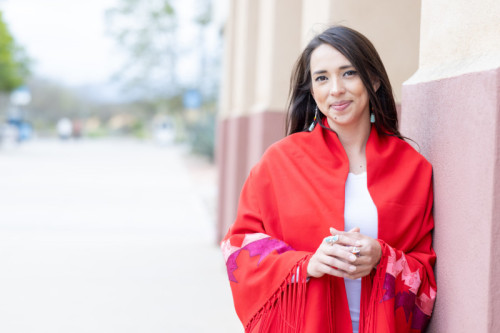
- After Surviving Battle With Hep C, Alumnus Now Helps Others Do SameRichard Jaenisch had received a death sentence at age 12. Diagnosed with hepatitis C, very unusual for a child that young, Jaenisch had been told by doctors that if he didn’t get a liver transplant, he wouldn’t live past 30. That disturbing prediction had hung over his adolescence and early adulthood like a black cloud, casting a pall over every doctor’s appointment and health episode. Now here it was, 2016, the year when Jaenisch turned 30, and the doctor’s assessment was feeling eerily prescient. He had not been able to procure a new liver, and his condition was deteriorating rapidly. To borrow his gallows humor, he was as “yellow as a Simpsons character” because of jaundice. He collectively spent more than six weeks in the hospital as a result of various complications from end-stage liver disease. “Every single day that year, I had a 30 to 60 percent chance of dying,” Jaenisch said. That he didn’t die, that he received a liver transplant on Dec. 3 (only a few months before his 31st birthday), Jaenisch considers to be nothing short of a miracle. Given the gift of fresh life in his fourth decade, he elected to devote it to ensuring that no one else has to go through the ordeal that he did. Three years later, Jaenisch returned to Cal State San Marcos – the university where he had earned a bachelor’s degree in social sciences in 2008 – to pursue a master’s in public health. He now works as the director of education and outreach for Open Biopharma Research and Training Institute, a Carlsbad nonprofit whose mission is to reduce the cost of pharmaceuticals like the ones that helped keep him alive while he waited for the miracle liver. More significantly, Jaenisch is a tireless patient advocate, dedicating countless hours to multiple organizations that share a goal of ending the scourge of hep C. He has transformed adversity into community impact, leveraging his CSUSM education to improve lives and strengthen public health across the state. “Richard is truly a special person,” said Carrie Frenette, the executive director of global medical affairs for Gilead Sciences and Jaenisch’s liver doctor for nine years starting in 2012. “I can’t think of anyone else who has so much expertise and understanding in their medical problems, advocates for themselves and then goes on to advocate for others. Honestly, it made it so easy to care for him, and it made it mean even more when he got his transplant and was healthy again.” 'I don’t know how you are still alive...’ It all started with brown pee. Jaenisch was a normal suburban kid growing up in Rancho Bernardo. When he was 12, his parents signed him up for a summer tennis camp. It was a sweltering day and he didn’t drink a lot of water; when he returned home and went to the bathroom, his urine was dark. His father took him to Rady Children’s Hospital, where he was put through a battery of tests on his kidneys, spleen and liver. The diagnosis of hepatitis C virus (HCV) stunned them, as did the subsequent wallop of bad news: After the rest of the family was tested, it was discovered that he contracted the infection at birth from his mother, who also was found to have HCV. Nothing, though, could have prepared Jaenisch for the haunting prognostication of liver transplant or death. “That shook me to my core,” he said. “My childhood was fundamentally changed. And my mom heard that, too, because she was in the room. It’s awkward hearing your own future from your child’s diagnosis. We shared a very odd relationship in that way.” At the time, in the late 1990s, there was no cure for HCV, only experimental treatments with low success rates and punishing side effects. Jaenisch’s mom started the drugs – interferon and ribavirin – almost immediately, but as a child, Jaenisch wasn’t eligible. The primary impact of HCV on his teenage years was that he was forced to cease participation in all sports and PE classes (because the disease can be transmitted through blood) and he began to suffer from a type of brain fog named hepatic encephalopathy (HE). After graduating from Rancho Bernardo High School, he attended Palomar College for two years, then transferred to CSUSM. There, he threw himself into classes in economics, history and political science – not only to satiate his hunger for knowledge but also to distract himself from the fear that constantly lingered at the back of his mind. “I wanted to live as much of my life as I could before everything hit the fan,” Jaenisch said. “Because I knew what was coming. When someone gives you a death sentence, you remember it, to say the least.” Jaenisch graduated from CSUSM in December 2008. Only a few weeks later, the trouble started. He attempted to begin the same treatment program his mom had undergone, but because of denials by his mom's employer, he wasn’t able to do so for about nine months. Once the snags finally had been resolved, the 12-week regimen of interferon and ribavirin didn’t work. He experienced all the negative effects of the drugs – in his case, painful inflammation and wild emotional swings – without any decrease in his body’s viral load. A second round at double the dosage early in 2010 similarly yielded no response. By this point, more than a decade after his HCV first had been discovered, Jaenisch had descended to the most serious stage on the scale that measures liver fibrosis, or scarring. F0 equates to no fibrosis, F1 is mild, F2 is moderate, and so on. He was at F4, which indicates the presence of cirrhosis, a condition in which the liver is extensively scarred and permanently damaged. Jaenisch had reached the dreaded end-stage liver disease, which essentially meant that the ticking of his clock was only accelerating. All the while, he was encountering roadblocks in his career. He had hoped to enter the niche field of traffic economics, but graduating into the Great Recession scuttled that plan. For a time, he held a job in tech support that he found unfulfilling. The work that did bring Jaenisch joy was for a group that offered before- and after-school services for elementary and middle schools in the Poway district of his youth. He envisioned a long-term future in that field but was stymied by both the ailing economy (which led to layoffs) and his illness (he claims he was a victim of disability discrimination but chose to spend his remaining time trying to get better rather than pursue a case.) While he tried to piece together enough work to retain his vital health insurance, Jaenisch’s health continued to deteriorate. In 2014, two years into her stint as his liver doctor, Frenette proffered a grim evaluation. “She said, ‘I don’t know how you are still alive with this liver,’ ” Jaenisch recalled. “She showed me pictures and was like, ‘Your liver is an old shoe. It is not doing what it’s supposed to do. But you’re still functioning.’ ” Every moment of optimism, it seemed, was followed by a stroke of misfortune. He began taking a new drug called Sovaldi (a direct-acting antiviral, or DAA) that was considered a game-changer for HCV patients in that it had an 86% cure rate in six months. Sure enough, Jaenisch’s viral load was approaching zero and his liver was curing. But then he contracted a C. diff bacterial infection (the suspect: spoiled food from a restaurant), which caused acute liver failure and brought his HVC roaring back. He later tried another second-generation DAA – Harvoni – that sounded promising but failed in the last week of treatment. As his liver continued to deteriorate, in 2016 he became too sick for treatment and, following a now-common hospitalization, an ER physician gave him outdated medical advice, which resulted in a case of sepsis that nearly killed him. End-stage liver disease is typically a rapid descent lasting as little as two years. For Jaenisch, it was an eight-year slog, from age 22 to 30. “He was in and out of the hospital multiple times, and he nearly didn’t make it to transplant multiple times,” Frenette said. “I can’t imagine anyone going through it with the courage and strength that he did.” Even after the liver transplant, Jaenisch wasn’t out of the woods. The operation addressed the issue of the failing liver, but it didn’t eradicate the HCV (the virus lives in the bloodstream). Frenette advised a treatment plan of Sovaldi, Zepatier and ribavirin, and that pharmaceutical concoction proved to be a magical formula. In September 2017, 18 years after the fateful diagnosis, Jaenisch was cured. “Honestly, I cried,” Frenette said. “He had been through so much, and to finally get rid of this awful virus that he had lived with his entire life and had caused his liver to fail … I don’t have words.” ‘I have to be more than a self-advocate' It was during one of his dozens of hospital stays that Jaenisch decided on the next course of his life, provided he would live long enough to choose. In the fall of 2014, he had been admitted to Sharp Memorial Hospital after the HCV returned via his C. diff infection. His medical team was struggling to lower his levels of bilirubin, a substance found in bile that was causing jaundice, the yellowing of the skin now so familiar to Jaenisch. He knew that ultraviolet rays help break down bilirubin, so he convinced the nurses to bring him outside for an hour a day at peak sun. As he had theorized, his bilirubin numbers declined. “It was at that point where I was like, ‘I have to be more than a self-advocate. If I can survive through transplant, I need to go to a Master of Public Health program,’ ” Jaenisch said. “I realized that that path would help me better understand how to become an advocate not only for myself but also for others.” His commitment would be nurtured in an environment like CSUSM, as he was accepted into its accelerated MPH program. His time back at the university overlapped with the pandemic, which he took advantage of by choosing as his thesis topic the emergency use authorization of COVID-19 tests. “He was very inquisitive and passionate,” said Asherlev Santos, an associate professor of public health and Jaenisch’s thesis adviser. “Sometimes that passion was more visible than the evidence of the inquiry, but all came from a place of helping others in some sort of need. He used his personal and professional experience to spur on what he did for his MPH degree.” His master’s allowed him to land his job at Open Biopharma, but it’s passion that mostly fuels Jaenisch in his advocacy connected to HCV. In 2016, while his body was still racked with the disease, he traveled to Sacramento with an organization known as CalHEP to talk to state legislators and raise awareness about viral hepatitis. The next year, when Congress was preparing to vote on a bill to repeal the Affordable Care Act, Jaenisch enlisted in the fight. He told his story of overcoming HCV in half a dozen TV interviews, worked at a call center, wrote letters – he did so much that the American Liver Foundation named him its liver champion of the year. “I wanted to preserve the things that help people get access to health care,” he said. “Because to me, it saved my life.” He also has volunteered for state and local groups such as End the Epidemics, the California Department of Public Health and the Eliminate Hepatitis C San Diego County Initiative. Their shared objective (in line with a goal established by the World Health Organization) is to eliminate hep C by 2030, which means a reduction of new infections by 90% and deaths by 65%. And the barriers are much lower than they used to be. Jaenisch says his family spent hundreds of thousands of dollars on treatment and other expenses to keep him alive. Today, treatment could run as cheap as a few hundred dollars, and that’s for more effective drugs, too. “I was raised in a middle-class suburban household, and I wouldn’t have known I had hep C if I didn’t pee a brown color,” Jaenisch said. “I’ve always maintained that I think we’re missing a lot of people, and I keep trying to push for us to find them and knock this virus out. We’re taking a lot of steps, and eventually we’ll get there.” Thanks to Jaenisch’s focus on access and innovation, those steps are becoming strides – toward a healthier, more equitable future for all. Media Contact Brian Hiro, Communications Specialist bhiro@csusm.edu | Office: 760-750-7306
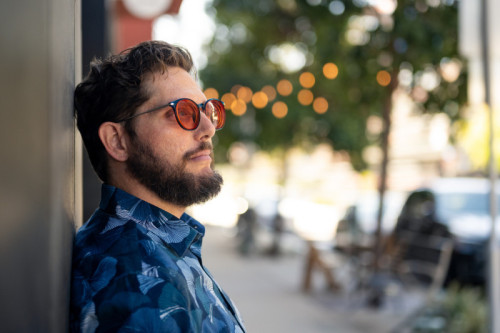
- MBA Graduate Builds Meaningful Career Helping Domestic Violence SurvivorsAs co-executive director of Kathy’s Legacy Foundation, Alex Lutz will tell you that no two days are ever the same. One moment she’s assembling raffle baskets, the next she’s reviewing financial statements. “It’s almost like you could take a Fully Employed MBA class schedule and go, ‘OK, yep, you’ve tapped finance, you’ve tapped accounting, marketing, leadership,’ ” Lutz said. “Somehow, I have to wear one of those hats at any given point in my job.” Founded in the wake of a tragic act of domestic violence, Kathy’s Legacy Foundation honors the memory of Kathy Scharbarth, who was murdered by her ex-boyfriend in 2011. The nonprofit supports children and pets impacted by domestic violence – offering comfort, stability and hope through its two signature programs. Lutz, who joined the organization in 2019 after earning an MBA from Cal State San Marcos, thrives on the variety and challenges of nonprofit work. Her time at CSUSM helped her develop a deeper understanding of her strengths and areas for growth, while also fostering connections that continue to support her in her role today. “CSUSM helped me focus on what I felt like my strong suits were and what I liked and didn't like,” Lutz said. “The personal connections I made at CSUSM have become invaluable professional resources.” Years after graduating, Lutz came full circle when she collaborated with CSUSM business students on their Senior Experience project for Kathy’s Legacy. Although the project was ultimately cut short due to the pandemic, Lutz felt a strong connection to the students because she had completed similar projects while earning her MBA. “The project was marketing-focused, and we were working to try to reach donors who resonate with our mission, " Lutz said. “I was bummed that we didn't get to finish in person together, but I loved getting to work with them as someone who has gone through the same experience. It was great, and we got some amazing materials in return.” Lutz first connected with Kathy’s Legacy when a friend asked if she’d be interested in consulting on an event for the organization. She was immediately drawn to the mission and soon after was hired full time as a program manager. In the ensuing years, she steadily took on more responsibility, stepping into the role of co-executive director in 2024. “I feel like jumping in wholeheartedly and putting everything I had into Kathy’s Legacy led me to where I am today," Lutz said. The foundation’s work centers on two initiatives: the Silver Lining program, which helps children heal from the trauma of losing a parent to domestic violence, and the Lady’s Legacy program, which was inspired by Scharbarth’s yellow labrador, Lady, who was present when Scharbarth was killed. Lady became a symbol of the often-overlooked impact of domestic violence on pets. Lutz now helps coordinate multiple fundraising events throughout the year, including the annual Kathy’s Legacy Golf Tournament held at Twin Oaks Golf Course in San Marcos. The work isn’t easy, but Lutz says the impact is clear at the quarterly events Kathy’s Legacy hosts. There she sees firsthand how the organization is changing the lives of the children they support. “We had one boy who was not doing well during COVID and even long after the pandemic would wear a mask and have his hood up,” Lutz said. “But in the past year, the hood has come off and he’s smiling and engaging, which means something we’re doing is working. “I love that we can be that beacon of light and that reliability that these kids don't have anywhere else.” Media Contact Eric Breier, Interim Assistant Director of Editorial and External Affairs ebreier@csusm.edu | Office: 760-750-7314
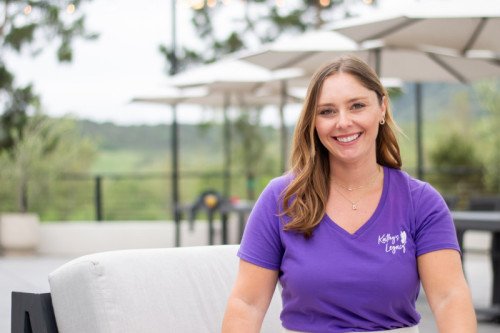
- Chronic Illness a Journey of Strength, Self-Discovery ... and SaltThe first time I rode in an ambulance was in May 2024. I was in the middle of my 10:30 a.m. Communication 200 class when I realized my vision and hearing were failing. I couldn't keep my legs or arms straight and I couldn’t speak. The full memory is hazy, but I found myself sitting outside of Crash’s Market in the University Student Union with a handful of salt packets and on a Facetime call with my parents, who live in Tennessee. This experience didn’t come out of nowhere. I have postural orthostatic tachycardia syndrome, or POTS, a chronic condition that I’ve lived with since my junior year of high school. There’s not a lot known about POTS, but it's a disorder affecting the autonomic nervous system. When I switch positions (postural) – especially when I go from sitting to standing upright (orthostatic) – my heart rate rapidly increases. On average, it's over 100 beats per minute (tachycardia). POTS leaves me with a slew of symptoms. Daily, I experience dizziness, nausea, fatigue and brain fog, among others. Some people who have POTS faint frequently, even daily. I'm lucky enough that this doesn't typically happen to me, but I do experience presyncope, which means I go through all the symptoms of passing out while still fully conscious. When it occurs, I'm not able to see, speak or hear anything. I’m so dizzy I can’t walk straight. I get heat flashes. I remember only bits and pieces of what happens during these moments. The severity of my symptoms can vary, leading to an episode like the one I suffered in May 2024. If I have been walking or standing for too long, sitting for too long, am stressed out or if it’s hot outside, there’s a higher chance of an occurrence. That day in May, while I was on the phone and sitting outside of Crash’s Market, my parents called the paramedics. Determining that I couldn’t walk anywhere on my own and wouldn’t be able to for several hours, they took me by ambulance to the emergency room at a nearby hospital. Though it was my first time in an ambulance, I had made frequent visits to the ER over the previous four years. The process this time was the same as it had been for prior trips: They measured my vital signs, checked my heart with an electrocardiogram and did blood work to confirm POTS as the reason for the incident. Then I received an IV. IVs have been incredibly helpful. People with POTS struggle with low blood volume and tend to get fewer nutrients from the food we eat. An IV provides quick hydration and extra electrolytes. I also constantly consume extra salt, which helps improve blood volume. I add salt to my food, but in extreme cases, I will just eat plain salt packets. At restaurants, I always take an extra handful of salt packets from the condiment stand. These live in my purse or backpack, and I keep them handy in case I feel an episode coming. Some of my friends even carry salt packets when they’re hanging out with me. Despite the challenges, I try to focus on the positives. This journey has taught me to advocate for myself and surround myself with people who care about me, which is easy to do at Cal State San Marcos. Self-advocacy became a necessity as I went through many months of doctors’ appointments during high school trying to figure out what was wrong. Several doctors said everything I was going through was normal. But I knew it wasn’t. I wasn’t officially diagnosed with POTS until two years after my first symptoms. I had COVID twice during that time, and doctors believe that may have exposed an underlying condition. POTS is a chronic illness, meaning there is no cure. I’m a regular at the doctor’s office, with multiple appointments every month. Attending events causes heightened anxiety – both for me and the friends I’m with – and I do my best to be prepared in case of an episode. I had to take another ambulance ride in March. A friend and I were at a Kelsea Ballerini concert in San Diego. Though I had been fine the whole day, I started feeling nauseous and dizzy during the first opening act. I couldn’t stand. By the time Kelsea took the stage, the combination of the heat, crowd and strobe lights proved too much. My friend had to help hold me up as she guided me down the stairs to find the medics. Situations like this are frustrating. I don’t want to be a burden to friends and family, and I don’t want friends constantly worrying or family having to pick up slack. I’ve made some lifestyle changes in an attempt to lessen my symptoms. I take daily medication to ensure that my body keeps the right balance of salt and water. I drink tons of water with extra electrolytes and salt added. I try to walk every day to get my body more adjusted to moving. On hot days, I carry a mobile fan. And I also make sure to eat well. When I decided to attend CSUSM, the Disability Support Services office proved invaluable – they set me up with first-floor housing so I could avoid stairs (and anyone who has spent time on campus knows it’s no easy task to avoid stairs at CSUSM!). I also have learned to be more open about my condition. Through my on-campus job as a writing intern in the University Communications office, I’ve made great friends and found people who understand and support me. The experience has been an important part of pursuing my goal of becoming a writer. While CSUSM has helped me grow, my family and I made the difficult decision for me to move back to Tennessee at the end of the spring semester to focus on my health. I’ve had my share of challenges, but I also know how difficult it has been for my family to get calls in the middle of the night to learn I’ve been taken by ambulance to the ER when they’re 2,000 miles away. Though I’m heading east to finish college, I’ll always be thankful for my time at CSUSM – for the friends I’ve made, the support I’ve received and the confidence I’ve gained in sharing my story. Media Contact Eric Breier, Interim Assistant Director of Editorial and External Affairs ebreier@csusm.edu | Office: 760-750-7314
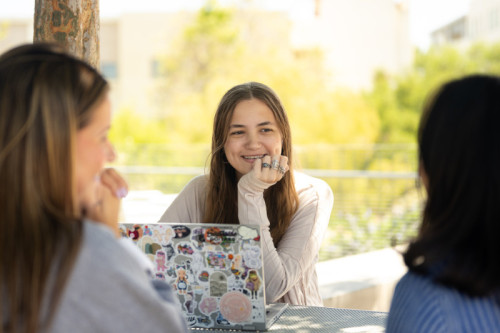
- Firefighting Proves to Be ‘Hand-in-Glove Fit’ for GraduateDwaine Collier always has thought of himself as a guy who runs toward the frightening things that most people run away from. As a boy, his career aspiration was to be on a SWAT team. As a student at Cal State San Marcos, though his academic track early on was kinesiology, he gravitated to the theater and began auditioning for every high-pressure stage role possible. So when Collier was at a crossroads in his post-graduate life and his stepfather figure suggested that he explore firefighting, perhaps the most surprising aspect is that Collier had never thought of it himself. Who, after all, is more willing to charge headlong into a risky situation than a firefighter? “I’m the person who will stop their car on the side of a busy road to help somebody rather than driving on,” Collier said. “That’s just what I do. It’s what’s in me. So for me, this job is a hand-in-glove fit.” Collier was speaking from a common area inside San Diego Fire Station 43, which is in Otay Mesa and has been his home away from home for the past year. On this day in late April, he had donned his gear several times to go on calls in the station’s primary engine with his firehouse colleagues – a firefighter paramedic, an engineer and a captain. The calls were fairly routine. Because Station 43 is in a lightly developed neighborhood only a few miles north of the Mexico border, most of the emergencies that its crews respond to are vegetation fires, car fires and incidents at the border itself – often people sustaining injuries as they try to cross into California illegally. Collier, 29, is less than four years into his firefighting career, which translates into this current assignment far from the heart of San Diego. He has to gradually work his way up the ranks and into more plum stations. But Collier still loves where he is and what he’s doing. He gladly will show off for visitors every nook and cranny of Station 43 – from the exercise space where he gets to incorporate one of his favorite activities (weightlifting) into his work hours, to the kitchen where he frequently cooks meals for the whole house, to the cherry-red fire engine that he has come to know every inch of like the back of his hand. “Becoming a firefighter is one of the best decisions I’ve ever made,” he said. “It’s not an easy job. When the stuff hits the fan, it sprays everywhere. But it’s also one of the most rewarding things you can do.” It was at CSUSM that Collier discovered the stability and self-confidence that made life as a firefighter seem realistic. He grew up in the foster system and entered the university having attended an astounding 17 different schools before he even reached high school, Olympian in Chula Vista. He arrived at CSUSM with the assistance of ACE Scholars Services, the university’s program for former foster youth. Collier switched his major from kinesiology to visual performing arts and threw himself into theater with abandon, ultimately starring in seven shows during his five years as a student. “What CSUSM gave me is the belief that I can do anything,” said Collier, who graduated in 2018. “I came into college with extreme educational deficiencies. Yet CSUSM had every tool to catch me up and help me succeed. It gave me the environment to grow.” Collier intended to pursue a Master of Fine Arts and a doctorate en route to becoming a theater professor, but he admits that he didn’t prepare well enough for his graduate school auditions and was delivered a harsh “reality check.” He was teaching kids at Callan Swim School when his stepdad proposed what turned out to be a fateful visit to the Heartland Fire & Rescue station in El Cajon. He was a reserve firefighter there for a year before entering the San Diego Fire Academy in 2022. Now Collier aims to keep climbing the ladder – both literally and figuratively – as a firefighter while not pulling it up behind him. As soon as he joined the fire service, he got involved with community outreach as part of the team tasked with recruiting the next generation of firefighters. And his next goal is to take classes toward becoming an instructor of young firefighters eager to enter the fire service. “I feel like that’s my next calling,” he said. “I’m trying to figure out how to give back by motivating and helping others. It gives me joy to see people be uplifted and accomplish things.” Media Contact Brian Hiro, Communications Specialist bhiro@csusm.edu | Office: 760-750-7306
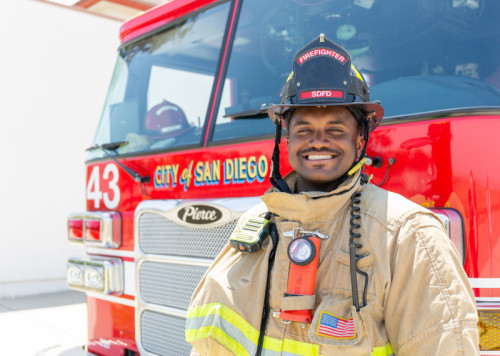
- Alumna Took Unorthodox Path to Leading Local Health Care StapleMichelle Gonzalez was a Cal State San Marcos student only about a month away from graduating in 2003 when she started working for an organization then called North County Health Services. Her degree (communication) was unrelated to health care, and Gonzalez had no intention of staying in the field. The main appeal of the job was that it was close to her home and the university. Beginning her journey as a program assistant in an entry-level role, Gonzalez quickly developed a fondness for the local nonprofit and its high-minded mission: providing quality health care and wellness services to underserved communities, regardless of income or insurance status. Her early connection to community health mirrored CSUSM’s commitment to accelerating social mobility through leaders who serve with purpose. What Gonzalez imagined to be a brief pit stop instead turned into a rewarding career, and over two decades, she climbed the rungs all the way to the top – she was appointed president and CEO in 2020, the same year that North County Health Services was reborn as TrueCare. With Gonzalez at the helm, TrueCare has expanded into a regional force with 21 health centers and five women, infants and children (WIC) locations, covering a footprint of more than 42 miles, from Encinitas to Ramona. Her leadership has driven key advancements, including the opening of new health centers, expansion of the mobile fleet and specialty services, implementation of an advanced electronic health record system, rebrand of the organization, and launch of a successful doula program supported by a $2 million federal grant. Question: This year marks the five-year anniversary of you becoming the leader of TrueCare. What does that milestone mean to you? Michelle Gonzalez: I think it's a reminder of how quickly time flies and how quickly things can change and evolve. It's hard to remember that we were in this worldwide pandemic. It feels like it's been a couple lifetimes. We've had a lot of growth for the organization, and I think at this five-year mark, it just underscores how resilient we are, how much people matter at the core of everything we do – whether it's providers, whether it's patients, whether it's the community, our staff. It's a culmination of the strength of the organization and everything that we've accomplished, which is a lot in the last five years. Q: How would you sum up the growth and changes that have occurred since 2020? MG: We've expanded our footprint. We've opened new sites, we've added new service lines, we've added acupuncture, we've added podiatry. We've really stabilized our workforce during a time of a lot of shortages and uncertainty. I’m proud of the fact that our provider retention rate is over 90%. We continue to hire at an accelerated pace, and I start there because everything we do, all the growth and all the accomplishments, it always starts with people. Without a solid workforce, we wouldn't be able to achieve anything. Our patient population has grown significantly as well. We had a slight decrease post-COVID, but we're back up to almost 70,000 patients. We've rendered more than 350,000 visits in this last year. Our workforce continues to grow. We're over 800 employees now and close to 160 providers. And then our budget has grown significantly, by almost $55 million in the last five years. We've tripled our mobile fleet. In all the areas of the business that you would expect to continue to progress, we're not only progressing, but we're thriving. Q: How did your appointment as CEO come about? MG: My predecessor went on a leave of absence in January 2020. The board asked me if I would be willing to step in on an interim basis. They were initially planning to do a national search, which I was fully supportive of. I didn't have any aspirations to be a CEO. I sometimes say I'm an accidental CEO. I was working in that interim capacity for several months, and then COVID made its presence known and we had the stay-at-home order. By April, the board had unanimously appointed me to maintain the position full term. After a lot of conversation and some prayer and reflection, I decided to pursue the position, and it's been a fantastic journey, in large part because I have such a great team around me. Q: What was the biggest challenge in taking over just as the pandemic was heating up? MG: There was so much uncertainty and fear. At one point, we had to close more than half of our clinics, probably 75-80% of our sites, we had to furlough staff. You think you can sort of ease in to becoming a CEO. There was no ease-in period. I remember talking with colleagues in the industry and saying, “How are you handling this? What are you doing?” And I realized very quickly that there's no playbook and everybody was truly figuring it out as they went along. Very early on, I made a conscious decision that I would be the type of leader who was always grounded and surrounded by strong advisers. We offer health care, but I'm not a clinician, so I made certain that we had strong clinical leadership on our team. It was about trying to understand what was unfolding in the world around us and how TrueCare plays an important part and ensuring that we were keeping our workforce intact. We’re back on track now, but it was an incredibly stressful time. Q: How did TrueCare pivot during that time and how does the organization look different now than it did in 2020? MG: Before the pandemic started, we had pieces of a telehealth or virtual health program. We realized very quickly that it would be crucial to continue to offer services to patients. For many patients, we are their lifeline, and cutting off their health care was not an option. So we were able to stand up a virtual health program in three days. It started off with telehealth visits and as soon as we were able to, we migrated to a video visit platform. We essentially worked around the clock to make sure that we didn't cut off access for patients, but it also gave employees a sense of purpose. And we've continued to build on that virtual health program while staying true to the traditional methods that you would expect to render medicine. We also had to pivot when it came to figuring out what our workforce was going to look like. We had to put people on furlough, but we made sure they still got a salary. We really believed that we needed to take care of our people, and a lot of funding from the federal government helped to shore us up. We laid off less than 15 individuals, and we were able to provide them with a severance so that they landed on their feet. I’m proud of that. Q: How would you characterize the change in you that turned TrueCare from a short-term job to more of a calling? MG: What I found was that people who worked here were very connected to the mission. They weren't here for the money. They were here because they cared about the people and patients that we were serving. The more I learned about the organization, the more in love I became with it and the more I realized, “My gosh, we have to make sure more individuals in the community and more community-based organizations know about what we do because there are so many people in need.” There was a misconception about people who were accessing care at community health centers, that they deserved less or they were just poor. I discovered that these are individuals who work very hard and who don't understand the importance of preventative care, and a lot of times don't feel like they're worthy of having access to care. What became a cornerstone of the work I did early on, and has carried on throughout my time here, is making sure everybody understands that access to health care is a right, not a privilege, and we don't care about your walk of life, where you come from or your circumstance. We want to make sure we help everyone who walks through our doors to the very best of our ability. Q: Tell me about your background. MG: I was born in Virginia, which is where my father is from. My mother is from Guam, and my parents met there while my dad was in the military. I'm half-Chamorro and half-white, and my husband is Mexican. We were childhood sweethearts who met when I was 12 and he was 14. I've had a lot of exposure to his family and culture over the years, and I think that's something that has benefited me very well. Though I'm not Mexican, I'm not Latina, I have such an appreciation for the culture and the people who we serve, which is the predominant background of our patients. My family traveled a lot while my dad was in the service. We moved to Vista when I was in third grade, and I've lived in North County pretty much my whole life. I'm also the youngest of seven children and the first in my family to go to college. So I'm a first-generation college graduate. Q: Did your parents not encourage college among your siblings? MG: We came from very humble beginnings, and I don't think we always understood that college was something within reach. My parents did the best they could to work and provide for us, but it was really the mindset of, you go to school and you get a good job. But my mom would say to me, “You're too smart, Michelle. You need to think about college.” I told her we couldn’t afford college, but she said we'll figure it out, we'll find a way. For most of the time that I was a student, I worked two jobs to put myself through school. I was also an AmeriCorps member, so I was able to receive a grant. But none of it came easy and none of it was without sacrifice or hard work – not just for me, but those around me who supported me. Q: What I'm hearing is a story of social mobility. MG: Oh, one thousand percent. I think that's why Cal State San Marcos and TrueCare are such great partners. We see health care as a right, not a privilege, and we think it's fundamental and foundational to everything. I think it ties in beautifully with social mobility. And there's so much good that is happening at Cal State San Marcos. There's a lot that we do together, and social mobility is a big part of that. Q: One of the main areas in which TrueCare and CSUSM have partnered in recent years is mobile health clinics. How did that come about? MG: Once I became CEO and started serving on the University Council, I learned about CSUSM’s interest in having a mobile health unit. I connected with (nursing lecturer) Matt Mincey early on and said, “You don't have to go on this journey alone. We have mobile clinics. We're right here, let's partner, let's figure out how to do this together.” What started out small has expanded into working not just with the mobile team, but also with the School of Nursing, public health, the entire College of Education, Health and Human Services. It’s a great opportunity to give exposure to students and help them understand that health care doesn't just come in a traditional hospital setting, that there's this whole other life of community health. There's a ton of overlap where our interests align nicely with what CSUSM is doing. We go to the same community events, and CSUSM students are able to do outreach, blood pressure screenings, things of that nature. Then, as they move farther along in their studies, when appropriate, they're also able to do internships at TrueCare. Q: How would you summarize TrueCare’s model in terms of providing health care? MG: One of the things I want to emphasize is that TrueCare will not refuse services to anyone regardless of their ability to pay. What we're focused on is the individual and the family who presents and what services you need, and how we can either provide those directly or connect you with somebody who offers them. At TrueCare, we provide high-quality, compassionate care. Like we always say, “Health inside, welcome in!” Q: That seems like such a valuable service in the community – health care you don't have to pay for. MG: In today's day and age, it sounds like something very novel. Does that really exist? And the reality is that it does. When you believe in your core that health care is a right and not a privilege, you fight to make that a reality. And that's what we're doing. We're growing in all possible ways and we're maximizing wherever we can, in terms of the revenue we're able to generate. We take that and we pour it right back into the organization so that we can continue to expand our footprint. We put a lot of emphasis on making sure we can get people enrolled in coverage because we know that if you have coverage, that's a reduced barrier and you're more likely to access health care. But that's not the only barrier you will have to face and figure out. We also spend a lot of time and resources and energy in cultivating a fantastic culture internally. We believe that people who are joyful at work are more likely to do a better job and will pour that energy back into our patients and community. We make it a priority to care for our workforce, to really give them opportunities to advance, to grow and level up. What we find more and more often is that our patients are a direct reflection of our staff, and our staff is a direct reflection of our patients. Pouring into one is pouring into the other, and we're proud of that because health care is daunting – not just for the patient in terms of navigating, but it's also really hard work. One of our VPs many years ago said, “Michelle, we do noble work.” And I was like, “Yeah, this is noble work.” That's exactly what we do. Media Contact Brian Hiro, Communications Specialist bhiro@csusm.edu | Office: 760-750-7306
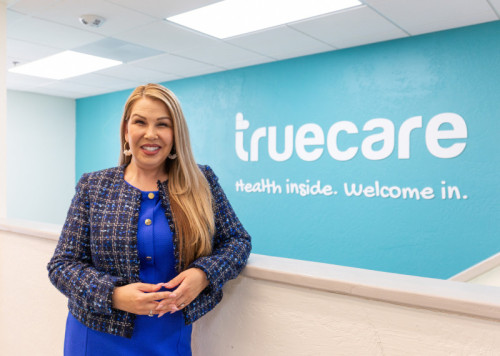
- Opportunity Knocks: Physics Grad Co-Founds Thriving CompanyMadison Perry didn’t have any type of physics background when he wandered through Science Hall 2 looking for research opportunities after his first year at Cal State San Marcos. Perry wasn’t worried about pay or even the tasks he would be doing. He simply wanted an opportunity to gain some hands-on experience. It wasn’t an easy sell, even if CSUSM is known for high-impact, experiential learning. Perry wasn’t a physics major (he was studying mathematics at the time), and he didn’t have any lab experience. Perry wasn’t having much luck when he knocked on the door of physics professor Stephen Tsui. “He just said, ‘Sure, why not?’ ” Perry said. The simple gesture was the catalyst for Perry’s switch to physics and the beginning of his journey to co-founding TP Engineering Services, a Poway-based company that builds laser and electro-optic systems for defense and fusion applications. The company has flourished since its founding in 2017, but a fusion contract that it secured three years ago has accelerated its growth. “It’s pretty insane to think about us getting to this point already,” Perry said. “Did I ever think we'd get here? Yeah, but I had no idea what it was going to look like, and I had no idea how it was going to happen.” The experience is similar to the one Perry had at CSUSM, where he practically lived in Science Hall 2 as a student. In fact, he was there so early and so late that the physics department eventually entrusted him with keys and after-hours access to conduct his work. “That was my thing – just being in a lab setting, being around hardware, being around something that was tangible, something that wasn't just theoretical,” he said. “It was where I could put my hands on hardware and get some experience.” After graduating in 2016, Perry headed north to UC Santa Cruz, where he earned a master’s in phototonics. His master’s thesis – on the design and development of a deep ultraviolet fiber laser system – caught the eye of a defense contractor who funded the project, leading to the formation of TP Engineering with his mother and father. TP Engineering quickly grew from an optics table in Perry’s bedroom where they navigated every project to the Poway lab it calls home today. The company has expanded from the initial trio of co-founders to over 20 employees, including two from CSUSM. The university still holds a special place in Perry’s heart. It’s where he met his wife, Amanda, who earned a bachelor’s in kinesiology. More than a decade after they met while both lived on campus in the University Village Apartments, they welcomed daughter Elli, who will be 3 years old in December. And he still returns to campus every year for Super STEM Saturday, an annual one-day science festival that brings thousands of community members to campus. A longtime supporter of CSUSM Giving Day, Perry increased his contribution last year with a matching gift for the physics department. “He's an alum who really believes in giving back,” Tsui said. “It's nice that so many of our graduates remember us so fondly and want to see younger alums and students do well.” That’s certainly the case for Perry. He doesn’t take for granted the impact that people like Tsui had on him and his career. “CSUSM took a chance on me a long time ago, and I want to support them being able to give other students a chance as well,” Perry said. “My professors gave me a unique perspective on life. If Dr. Tsui hadn't given me that opportunity to work in his lab, I don't know if any of this would have happened. They gave me a chance, and that changed me forever.” Media Contact Eric Breier, Interim Assistant Director of Editorial and External Affairs ebreier@csusm.edu | Office: 760-750-7314
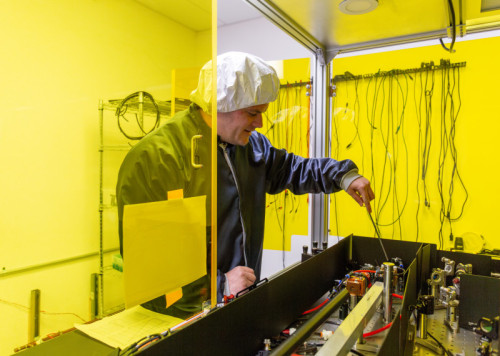
- Faith, Resilience Help Athlete Through Life-Threatening CrisisIt all started with a headache. A seemingly normal ailment, but Malachi Wright doesn’t get headaches. And he definitely doesn’t get headaches that force him to leave work early or have him confined to the couch and throwing up for three straight days. That's when his mom, Ivonne Mancilla, knew this was something more. It was the summer of 2023. Wright – who had just completed his second year at Cal State San Marcos, where he plays for the men’s soccer team – was experiencing pain like he had never felt before. “He has a high pain tolerance,” Mancilla said. “I started noticing how much he was sleeping and how he was walking very fragile. I realized it wasn’t a normal headache.” On the third day of the headache, Mancilla took Wright to urgent care. Doctors treated it as a migraine, giving him some medication and sending him home. But the pain continued to be unbearable. Wright told his mom that he felt like he was dying. On day four, Wright went to the emergency room. It saved his life. Wright spent the next 40 days in the hospital, undergoing three brain surgeries with no idea what the future would bring. No certainty if he could return to school, let alone soccer, his passion from the time he was a young child. But Wright defied all odds. “I hope to get my story out to people so that they can see anything is possible,” Wright said. “I am trying to bring people inspiration and give glory to God. That was my thing in the hospital, having faith and staying faithful to God, knowing that I'll be OK and he's got me.” Wright was guided by his faith throughout his hospital stay. He and his mom prayed throughout the journey, and she kept a bible verse at the edge of her son’s bed that they read every day as he fought for his life. It’s Psalm 30:2: Lord my god, I called to you for help, and you healed me. Those prayers began virtually the moment Wright arrived at the emergency room. A CT scan showed that his brain was filling with fluid, and an MRI revealed a cyst in the third ventricle of his brain. When a neurosurgeon came to review Wright’s scans, she was horrified. No one had informed her of his highly critical state. He was dying. “They said his brain was like a balloon and that it could burst at any moment,” Mancilla said. “I had to sign a paper giving them permission to go in and drain his brain immediately because he could have brain damage or die.” There was not space available or time to get Wright into an operating room. Instead, ICU nurses rushed into his room to assist the neurosurgeon, who numbed and drilled a hole in Wright’s head to drain the fluid. Doctors initially wanted to place a permanent shunt in Wright’s brain. Mancilla was a fierce advocate for Wright throughout his hospital stay, earning the nickname “Bulldog” from nurses. She was resistant to the shunt, worried it would affect Wright's ability to pursue his dream of becoming a firefighter. After she expressed her concerns, the lead neurosurgeon opted for a temporary shunt instead. Wright was in and out of consciousness for much of his time in the hospital, but a strong support system – including his mom, his aunt Vanessa, members of the family’s church, and coaches and teammates from CSUSM’s soccer team – played a crucial role in helping him through the process. The constant stream of visitors led Mancilla to discover the positive impact that Wright has had on so many people. His manager at Casero Taqueria, where he still works, reached out to Mancilla asking for permission to start a GoFundMe. The community raised $14,000, the exact amount needed to cover the family’s maximum out-of-pocket medical costs. “I didn't realize how many people Malachi has impacted,” Mancilla said. “Sometimes as a parent, you don't get to see all that until these types of things happen. Sometimes we focus a little too much on what they're doing wrong and not on all the other good things that they're doing that maybe they don't tell you about. “I told him, ‘This is all because of the seeds that you've planted out in the world, and this is how it's all coming back to you. So continue to be who you are.’ I am so proud of that. I was such a proud parent.” Wright endured three brain surgeries during his hospital stay. The first removed the majority of the cyst, the second cleared residuals of the cyst and the third addressed blood clots. It was a physically and mentally draining process. After the first surgery, Wright was temporarily paralyzed on his left side. He couldn’t sleep and was in constant agony. “It was the worst pain I felt in my life. It was excruciating,” Wright said. “It was really hard. I was confused, wondering where I was. It was a lot of scary stuff.” It wasn’t until Wright’s 35th day in the hospital that Mancilla felt like her son would be OK. His pain levels were reduced and he could walk again. But the biggest sign to Mancilla that Wright was doing better? He asked for his phone, which he hadn’t been able to use for most of his hospital stint. Though Wright’s pain was finally under control, other challenges remained once he left the hospital. He underwent cognitive, physical and speech therapy. Doctors expected the recovery process to take two years, but Mancilla knew her son had the fortitude for a quicker recovery. She could see that Wright was capable of more than he was initially allowed to do in the rehabilitation process, and her tireless advocacy paid off. Wright returned to CSUSM in the fall of 2023, just months after his hospital release. He eased back in by taking one class before increasing his load to three courses in spring 2024. He is grateful for the support he received throughout this time from coaches, teammates and athletic department staff, also noting the important role that CSUSM’s Disability Support Services played in helping him return to the classroom. A little more than a year after his three surgeries, Wright was back as a full-time student and soccer player. Wright didn’t just settle into classes, he thrived in them. He received a 4.0 grade-point average, making him the highest academic performer on the soccer team. “Not only did he heal perfectly, he's a better version of himself,” Mancilla said. “He turned something that caused him so much pain into good. He continues to make good choices for himself. He uses that painful experience and turns it into good.” That includes his efforts on the soccer field. Returning to the sport he loves was an impressive milestone for Wright, especially because it was considered virtually impossible just months earlier. Perhaps the most powerful moment of the 2024 season came in a match against Biola University. As the first half was winding down, Wright scored his first goal since the health scare. Mancilla, who never misses a game, ran down to the field. Coaches welcomed and hugged Mancilla as she rejoiced over the milestone. “It was a great, raw moment of emotion, love and gratitude,” said Ron Pulvers, CSUSM’s men’s soccer coach. “An experience I will never forget. “Malachi is a tireless worker in all aspects of life. He lives our core value of unconditional gratitude at the highest levels and lives his life with unequalled faith.” Wright is back on the field this fall as he continues work toward a bachelor’s degree in human development. He is scheduled to graduate in fall 2026, with an ambition of becoming a firefighter. While his time spent in the hospital was scary, the support he received helped him overcome adversity and his faith helped him remain positive. He now uses his experience to encourage others and push himself to perform the best he can. “People meet Jesus at the end of the rope. And that was the end of my rope,” Wright said. “Going through this whole experience with my brain really changed my perspective on life and it changed my character as a man.” Media Contact Eric Breier, Interim Assistant Director of Editorial and External Affairs ebreier@csusm.edu | Office: 760-750-7314
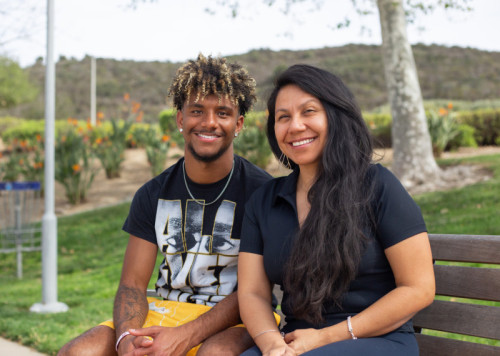
- Professor Blends Art, Science on Summer Trip to ArcticFor Judit Hersko, a two-week voyage to the Arctic Circle last summer was more than a bucket-list adventure. It was the continuation of a two-decade career turn toward venturing to – both physically and emotionally – some of the coldest, most remote places on Earth and exploring the fascinating ways that art and science intersect. Hersko, a longtime Cal State San Marcos professor who’s chair of the art, media and design (AMD) department, is back on campus this semester as she digests the discoveries she made on her summer sojourn to Svalbard, a Norwegian archipelago between mainland Norway and the North Pole. How far-flung is it? After traveling the 5,400 miles from San Diego to Oslo, you’re still about 1,300 miles from your destination. In Svalbard, Hersko boarded a sailing ship called the Rembrandt van Rijn (named for the famous Dutch painter) that was chartered by The Arctic Circle, an annual expeditionary residency program for artists and scientists from around the world. With 29 other people – a mix of visual artists, writers, composers and science communicators – Hersko sailed down the west coast of Svalbard before the ship left the land behind and pointed northwest into the thick ice of the Arctic Ocean. “That was really exciting because it was a real North Pole feeling,” Hersko said. “The captain discovered this really large chunk of ice that was 20 kilometers. We moored to it, and it was sort of like mooring to land, except it moved.” During her time at sea and on the ice, Hersko gathered material that she will use for her unique brand of artwork that she calls performance lectures. These are tightly timed presentations of narratives grounded in historical and scientific research that are accompanied by visual images, including the artworks that she creates – her specialties are sculpture and installation that also incorporate photography and collage. “I build complex narratives that are basically true to life, except that I weave in a fictitious character who helps hold the story together,” she said. It’s an approach to art that was born of Hersko’s early years at CSUSM, and a life-changing trip to the globe’s opposite pole. In 2003, when she was hired at CSUSM, she sent a letter to colleagues on the science faculty telling them that she was interested in collaborating on projects. One of the most enthusiastic responses came from Victoria Fabry, a biological sciences professor whose scholarly work explored the effects of ocean acidification. Hersko and Fabry teamed up on an exhibit titled “Shifting Baselines” that translated the scientist’s research into visual art (it proved so impactful that it has been exhibited multiple times nationally, most recently last year in the San Diego Central Library). In 2006, Fabry went on a scientific trip to Antarctica and she came back raving about it, urging Hersko to apply for a program that brought artists there. Hersko did just that two years later. On a completely funded expedition as part of the extremely competitive National Science Foundation Antarctic Artists and Writers grant program, she spent six weeks in Antarctica, where she watched penguins hatching at her feet, studied planktonic snails and assembled the research material that guided her work for many years, exhibitions, presentations and book chapters to come. Specifically, she crafted narratives that centered around a fictitious, unknown female explorer, Anna Schwartz, who travels to Antarctica disguised as a man on the 1939 expedition led by American naval officer Richard E. Byrd. Though her protagonist is invented, Hersko said, “my work builds on meticulous research, and I place her in real historical events. These layered stories present the complex history of science highlighting the absence of women from the narratives of exploration as well as science.” Hersko isn’t the only School of Arts faculty member who has been to the frigid poles on a research excursion. In 2023, AMD professor Lucy HG Solomon received a prestigious Fulbright scholarship and did part of her research on Svalbard, where she furthered her ongoing studies of microorganisms and how they connect to the world. Solomon’s experience in the Arctic, in turn, led to a rare opportunity for one of her students. Last year, she connected AMD student Leobardo Moreno Villanueva with an ecologist at a Svalbard university, and Villanueva worked with the scientist on a graphic design project in which he helped make technical signage describing the scientific equipment used for research in the Arctic. Villanueva, a former foster youth from Mexico for whom English is his third language, graduated from CSUSM last spring. “Designing for the far north was an unforgettable challenge that expanded my perspective on how art and science meet in unexpected places," Villanueva said. As for Hersko, she knows several people in the small circle of polar researchers who have traveled with The Arctic Circle program, but she could never find the right time until this year. On July 4, she landed in Longyearbyen, a small town known for coal mining (though the last mine closed a few days before her arrival) and its views of the Northern Lights. After a few days to acclimate, she boarded the Rembrandt van Rijn to begin the two-week voyage. Among the highlights of her time at sea was up-close viewings of two polar bears, the tragic sight (and thunderous sound) of ice falling from stunning glaciers, and the discovery of tiny flowers and lichens that she thinks she will incorporate into her next output of art that results from this latest trip of a lifetime. “When I get fascinated by something, often it turns out that things come together in a weird, magical way where it has relevance,” Hersko said. “It’s all still percolating, and I think it’s probably a story that I will develop in the next year.” Media Contact Brian Hiro, Communications Specialist bhiro@csusm.edu | Office: 760-750-7306
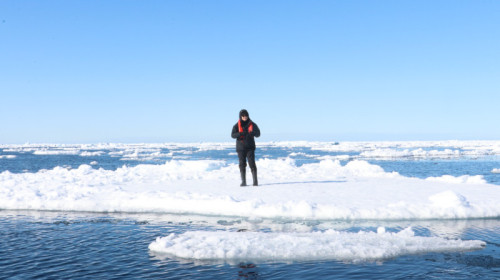
- Cougar Care Network Marks 10 Years as a Campus Hub for ConnectionBuilt on listening first and guiding without judgment, the Cougar Care Network enters its second decade as a trusted stop for students seeking practical help, community and a path forward. The Cougar Care Network (CCN) launched in fall 2015 as part of Cal State San Marcos’ Early Support Initiative within the Student Outreach and Referral (SOAR) program. Patty Diaz worked in Student Affairs and was the SOAR coordinator. Today, Diaz is the coordinator of CCN. “It’s an incredible feeling to witness something you’ve helped build flourish,” Diaz said. “I’m proud of what Cougar Care Network has become and the positive reputation it has gained among students, faculty and the entire campus community. Together we are making a real difference in the lives of students.” SOAR was the primary referral source for faculty teaching first-year and underserved students. It operated like a concierge: Students visited the office, where they were routed to other campus support systems, such as counseling or academic services. In fall 2016, SOAR rebranded as part of CCN. Today, CCN is a trusted place for students to build community while at CSUSM. “It’s fantastic,” said Donna Davis, CCN director. “It’s wonderful that the university has embraced us so much. And students know enough about us to walk right in with anything on their minds, knowing they can get some help. So we are honored by that every day.” Davis joined CCN in 2022 and became the program's director in 2023. “This team, they care so deeply,” Davis said. “We have a very dedicated group of professionals here that are creative, energized and excited to help students. I am so beyond honored to work with this group, and that is what’s kept me here through it all.” As CCN has grown over the past decade, so has the number of students it serves. During the 2024-25 academic year, it managed 4,620 student cases, a 58% increase from the previous year, according to CCN. There was an average of 20 new cases each day, and students expressed appreciation for the ease of being able to drop into the office to get immediate help with their concerns. While CCN does not offer long-term therapy, most of the cases involve mental health. The staff can provide advice and resources for issues like day-to-day anxiety, the stress of failing a test or the emotional roller coaster of going through a breakup. The team also helps students take their first step toward using counseling services on campus. “We spend a lot of time walking beside students until they are ready to take that step,” Davis said. Visiting CCN is easy and accessible. Students can email or submit a referral form to schedule a visit, or drop in to Administrative Building 1200, Monday-Friday from 9 a.m. to 5 p.m. Professors can refer students, and an assigned staff member will reach out to the student to check in and invite them to stop by. “Once we connect with them, we’re always going to make that person feel as comfortable as they can,” Davis said. One way that CCN helps students feel comfortable during their visits is by offering a treasure chest in the office. Filled with items like face masks, notebooks, fidget toys and mugs, the chest began as a form of staff appreciation and evolved into a fun activity for students to engage with. The treasure chest also gives students the opportunity to visit the office and become familiar with the staff while they’re still deciding if they’re ready to talk to someone. Another entry point is the Cougar Care Network cart, introduced in the fall of 2023. The cart is operated by service-learning students as an informal, peer-to-peer way for students to learn more about the program and build connections at CSUSM, so they know support is available. “We are students ourselves. We’re not faculty or staff,” said Fernando Vasquez Rendon, a fourth-year psychology major and service-learning student with CCN. “Knowing that we’re also students adds a sense of trust and relatability.” Vasquez Rendon said he understands why some students may feel nervous about approaching the cart, and he encourages them to interact with it and see what it has to offer. He said students often express gratitude for the cart, those who work it and the free items and resources it carries. “Please, come up to the cart. We’re always happy to chit-chat,” he said. “I’m always open and I really want students to know that I and the team are here to really listen and support. “One of the best parts is seeing a student for the first time and their interaction with the cart. Those interactions are what make this role beautiful, and I think those moments are really important.” CCN also uses the cart as a tool to help students connect with the University Student Union centers. For example, Davis explained that for students curious about the Pride Center but hesitant to walk alone, the card serves as a bridge, as students might walk into the center when the cart is there. “We know that there needs to be this kindness movement right now,” Davis said. “We know students are isolated and lonely. And regardless of how much social media they have – and the people they can connect with online – they’re still feeling alone on the inside. So the cart was started as a way to go over to students who are sitting alone and introduce them to the cart, because sometimes that’s the only person that student may talk to all day.” Lizet Palestina, another service-learning student with the CCN and a criminology major in her final semester, shared how she uses the cart to start conversations with students sitting alone. “I think it’s easier for students to talk to us rather than a staff member,” Palestina said. Once the conversation is underway, Palestina and other service-learning students inform students about campus resources, such as the CCN, Student Health & Counseling Services (SHCS), the Cougar Pantry and workshops. “There are a lot of students who are by themselves, and sometimes they’ll be nervous. But once you get the conversation going, they’re a lot more open,” she said. “It’s as simple as asking if they want a little duck, and then you keep the conversation going.” The mini ducks are one of the main reasons why students approach the cart. Vasquez Rendon said it's common to see students visiting the cart to add more ducks to their collection. The ducks serve as a small symbol to remind students that they’re not alone. “Put it in your pocket, keep it in your book bag. But take it out and physically hold onto it as a reminder that we believe in you and know that you got this,” Davis said. Along with the standard mini ducks, CCN also releases special-edition ducks for campus events. During a Commuter Breakfast event, the cart featured ducks in cars. In a previous collaboration with SHCS, a duck in a fry basket was offered in reference to the F.R.I.E.S. program on consent. F.R.I.E.S. describes consent as something freely given, reversible, Informed, enthusiastic and specific. CCN also rotates the cart's theme and available items based on cultural events and student feedback. Vasquez Rendon said the team is working to update the cart's theme for Dia de los Muertos and to provide cultural information about the holiday. “The cart is always changing as the student population changes,” he said. “I want students to know that the conversations we have don’t fall on deaf ears. If they bring up questions, comments or concerns, I always relay it back to the team.” Alongside the service-learning students, CCN also has a staff of Master of Social Work (MSW) interns who provide support to students. Vasquez Rendon plans to apply to the MSW program for the fall 2026 cohort. Davis said community donations and grant funding are crucial to ensuring that CCN can provide students the support they need. CCN is a part of the university's Community of Care program, an intentionally connected network to support students that was made possible by a generous grant from the Conrad Prebys Foundation. CCN also received philanthropic funding from a San Diego Foundation mental and behavioral health-focused grant to be able to staff MSW interns. “We’ve been very blessed with the grants, and they allow our MSW interns to dedicate their full attention to the students," Davis said. Community donations often help stock the treasure chest at the CCN office. Davis said new or gently used physical donations are always welcome and that students donate items like candles, face masks and other small gifts they no longer need. Ten years in, CCN remains focused on simple ideas that matter, starting with a warm welcome and practical help that arrives when students need it. The aim is to walk beside each person until the next step feels possible and the path forward is clear. “We’re here to walk beside you,” Davis said. “And if you’re not ready today, no worries. Maybe you’ll chat with somebody at the cart or follow us on Instagram. Just in case you need us, we’re here.” Media Contact Eric Breier, Interim Assistant Director of Editorial and External Affairs ebreier@csusm.edu | Office: 760-750-7314
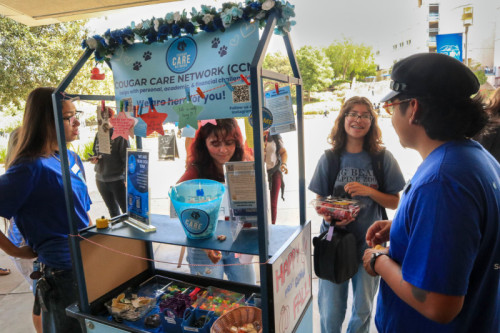
- In Memoriam: Josh Pack (’97), a Life of Leadership, Generosity and HeartCal State San Marcos is mourning the passing of distinguished alumnus Joshua Pack ('97), who died on Sept. 29. A devoted husband and father, proud Cougar, and tireless advocate for veterans and students, Pack leaves behind a legacy defined not only by professional success but also by kindness, humility and a deep commitment to helping others. Pack’s path to CSUSM wasn’t straightforward. After beginning his higher-education journey at the U.S. Air Force Academy and transferring to another university, he eventually found his home at San Marcos, where he earned a bachelor’s degree in economics in 1997. He often credited a CSUSM economics professor with transforming his academic trajectory and helping set the foundation for his career. Professionally, Pack rose to become co-CEO of Fortress Investment Group, one of the world’s leading investment firms. Over more than two decades, he built a reputation as a leader in credit and real estate investing, overseeing billions of dollars in assets and guiding teams through complex financial markets. Pack’s connection to CSUSM remained strong long after graduation. He gave his time and expertise as a member of the CSUSM Foundation Board from 2011-16, including service on the Fundraising Committee, where his vision helped strengthen the university’s philanthropic efforts. He also supported the Finance Society by offering real-world insights to students preparing for their own careers. Pack’s passion for serving veterans was rooted in his upbringing as the son of Lt. Col. A.J. Pack, a U.S. Marine Corps officer who served for 22 years. Like Josh, Lt. Col. Pack served as a director of the CSUSM Foundation Board (2015-21). In his father’s honor, Josh established the Lt. Col. A.J. Pack Veterans Scholarship at CSUSM, supporting military-affiliated students in pursuing their educational and career goals. He also championed the creation of a veterans and military center on campus, which broke ground in 2013, calling the work “enormously gratifying for me and my family.” In 2014, he partnered with the Veterans Center and Associated Students, Inc., to host the campus premiere of “The Hornet’s Nest,” a documentary about American troops in Afghanistan. The event included a post-screening Q&A with military units and filmmakers, underscoring his belief in the importance of recognizing and supporting student veterans. In 2021, Pack reflected on his connection to CSUSM in an article on the Fortress website, noting how meaningful it was to help create a leading center for veterans and active-duty service members at the university. “The CSUSM veterans community has earned not just our thanks, but our commitment to support their dreams,” he said. Pack will be remembered for the generosity he showed to his alma mater and to the veteran community that meant so much to him. Through the Lt. Col. A.J. Pack Veterans Scholarship, his support of campus programs and his advocacy for military-connected students, he built a legacy of service that will continue to impact lives for years to come. Pack is survived by his wife and their four children. “Josh was a true partner in our mission of student success,” CSUSM President Ellen Neufeldt said. “He had an unwavering belief in the power of education, and he never forgot where he came from. His impact on our students, and especially our student veterans, will endure for generations, and we will carry forward his spirit of service with gratitude.” Media Contact Eric Breier, Interim Assistant Director of Editorial and External Affairs ebreier@csusm.edu | Office: 760-750-7314
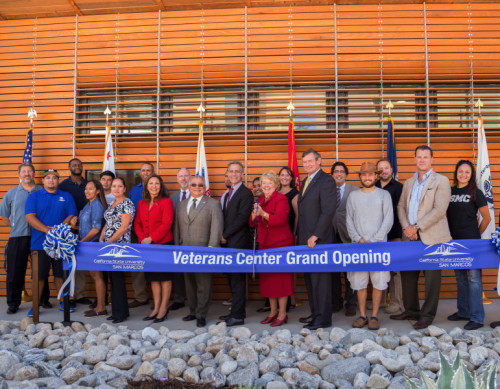
- Biology Professor Researching Breast CancerCarlos Luna Lopez’s typical day in the lab looks a little different from others. Dark, cool and full of machinery like 3D bio printers, the lab is home to petri dishes full of cancerous cells. Inspired by one of his students, his lab cohort is studying breast cancer. “Being in Dr. Luna’s lab has been such a great experience. He’s not only an amazing PI, but also a really great mentor,” said Oscar Loyola Torres, a molecular and cellular biology student. Luna, a biology professor at Cal State San Marcos, received a bachelor’s degree in physics from Universidad de Sonora in Mexico and a Ph.D. in bioengineering from the University of Maryland. He decided to pursue postdoctoral research closer to his parents, who live in Mexico, which brought him to UC San Diego. Luna always knew he wanted to pursue a career in the STEM field, as his father is a mechanical engineer and his mother a nurse. During his Ph.D. studies, he joined the Summer Program in Neuroscience, Excellence and Success (SPINES), where he met a former CSUSM biology professor who further inspired his move to San Diego and his pursuit of a job at CSUSM. Luna believes that finding a good balance between research and teaching is important. He explained that one of his biophysics professors would play soccer with his students and invite them to important seminars, creating a meaningful relationship with the students beyond just research. So when he was told of the community between faculty and students at CSUSM, it felt like the right choice to apply. Luna has taught upper-division cellular and molecular biotechnology classes as well as biostatistics and bioengineering classes at CSUSM since 2017. He also occasionally teaches advanced molecular seminars, and currently he and his lab students are studying the effects of fat cells on breast cancer growth. The tests examine how lipid metabolism is driving parts of cancer growth. Lipid metabolism is the process of creating or breaking down lipids (fats) to help with energy storage, structural cell membrane support and cell signaling. Since breast tissue is full of lipids, it creates the perfect environment for cancer cells to thrive, utilizing these functions to their advantage. Luna and his students monitor the interactions between cancer cells and two different types of fat cells, white and brown adipocytes. These cells work to store energy, produce hormones and regulate body temperature, all basic functions crucial to the success of the human body. Utilizing his background in engineering, Luna and his students built a device that creates spheroids, 3D circular clusters of cells. The spheroid is made of biomaterials replicating human tissue, allowing the students to get the most accurate results from their cancer research. “There are so many things I get to learn from him and the lab that are helping me grow as both a student and a future physician,” Loyola Torres said. Luna said this is only a portion of what their research encapsulates. Every time a new discovery is made, it opens a door for further questioning, and the research continues. “When you have something in your mind and you get the chance and the resources to be able to put that into the world, it’s so exciting,” Luna said. Luna loves watching his students grow and be creative, as it reminds him of when he was a kid. Not only can he exercise his own creativity, but he gets to bring his students along for the journey. With him having watched some of them grow from first years to graduating Ph.D. students, the relationship Lopez has been able to create with his students makes his job all the more rewarding. Media Contact Eric Breier, Interim Assistant Director of Editorial and External Affairs ebreier@csusm.edu | Office: 760-750-7314
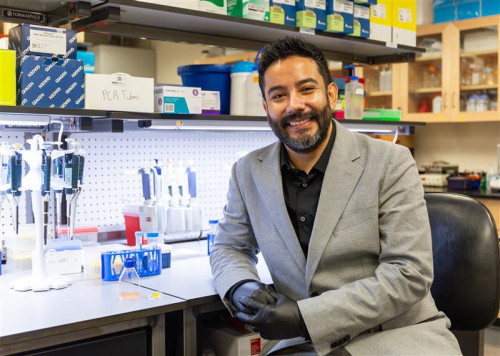
- Women's Soccer Team Finishes Nonconference Play With WinDanielle Paulson's goal in the 78th minute was the difference as the Cal State San Marcos women's soccer team beat visiting Cal State San Bernardino 1-0 in its final nonconference game of the season Sunday. Paulson scored on an assist from her sister, Natalie Paulson. The Cougars, who finished nonconference play with a 3-1-2 record, open the California Collegiate Athletic Association portion of their schedule on Friday at Cal Poly Humboldt. Media Contact Eric Breier, Interim Assistant Director of Editorial and External Affairs ebreier@csusm.edu | Office: 760-750-7314
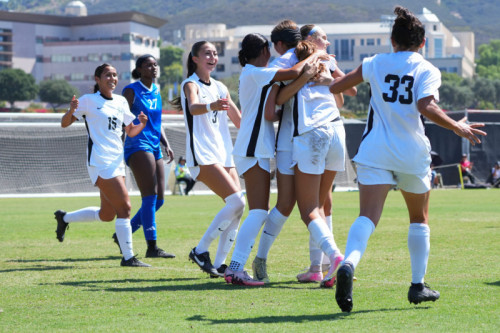
- Professor Goes on Tour for 20th Anniversary of Acclaimed FilmWhen Jonathan Berman came to Cal State San Marcos as a film professor in 2004, he was close to finishing a documentary about a Northern California commune during the counterculture era. The documentary was released the following year. Now, 20 years later, Berman is marking the anniversary of the film with a new digital restoration and a national tour of screenings and interviews. “Commune” is about an intentional community called Black Bear Ranch formed in 1968 in remote Siskiyou County just south of the Oregon border. A dozen people were expected to live there, but the number eventually swelled to 100 in what was a utopian experiment that attracted anarchists, hippies and activists seeking to get away from America and create something new. The documentary includes prominent actor Peter Coyote, who once lived at Black Bear. At the time of its release, “Commune” received positive reviews from such outlets as the New York Times, Variety, the Village Voice and the San Francisco Chronicle. It boasts a rating of 96% on Rotten Tomatoes. Berman says he decided to restore the film so that it would be suitable to appear on streaming services and that he chose to embark on a nationwide tour to give fans “the communal experience of theatrical.” The tour began in May in upstate New York and will end this month back in New York. In September, it made four stops in California, including Los Angeles and the Bay Area town of San Rafael, where some former Black Bear denizens reside. “Twenty years later, it is a warm feeling to reunite with those folks,” Berman said. “They have almost all gone on to do work that helps people; some of this can be gleaned in the film. It was almost like reuniting with relatives after a long time. I felt a little guilty for not really being in touch more, but then happy to see them again.” In addition to the 16 theaters that have screened “Commune,” Berman has been interviewed on nearly 20 podcasts. He’s hoping to add a few more showings in Southern California, including at least one in the San Diego area. After making “Commune,” Berman focused on teaching and consulting on other films before the release in 2018 of “Calling All Earthlings,” which examines California’s UFO counterculture cult and the Integratron, a mysterious structure in the desert north of Joshua Tree National Park. He’s now working on the third documentary in what he calls his California trilogy; titled “Gondola,” it’s about the controversial plan to build an aerial tram from Union Station to Dodger Stadium in L.A. Berman says his film work over the years has benefited greatly from the contributions of CSUSM students and fellow faculty members, from serving internships to watching and giving feedback on test edits. “That’s part of our mission as a university, for students to work intimately with teachers who are active in their field,” he said. Media Contact Brian Hiro, Communications Specialist bhiro@csusm.edu | Office: 760-750-7306
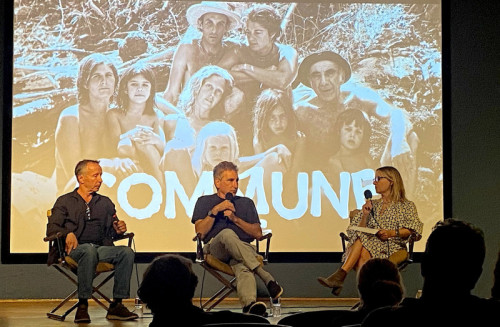
- 'It's Irreplaceable': Giant Oak Tree Saved in RelocationA giant oak tree as old as Cal State San Marcos itself was saved this month as part of a large-scale relocation project. The tree, which was planted around the time of CSUSM’s founding in 1989 and weighs 27 tons, was moved in early September from a plot outside the Arts Building to the area between Kellogg Library and Campus View Drive, near the main circle. “It’s not every day that you move a tree that size,” said Michelle Alves, a campus planner in Planning, Design and Construction (PDC) who helped supervise the project. The fate of the tree was thrown into question over the summer when Facilities Development and Management (FDM) began the construction of a new glass elevator on the perimeter of the Arts Building. Because the tree sat right next to the construction zone, the determination was that it would need to be uprooted to give it the best chance of survival. “That kind of oak tree, you could never buy one. It’s irreplaceable,” Alves said. The relocation occurred on Sept. 6 – a Saturday, to take advantage of minimal car and foot traffic on campus. Alves arrived at 5 a.m., planning to be on site for six hours; it turned out to be more than nine. In all, the project involved about 20 workers, including several from FDM and several more from an Escondido company called Big Trees Nursery. After landscapers boxed and harnessed the tree, a crane lifted it out of the ground and laid it on its side on a flatbed truck (a smaller truck after the first one proved too big to navigate the service road, causing an hour delay). On the drive northeast out of campus, the oak’s branches were so wide that they were brushing the overhang of the Arts Building and the trees outside Science Hall 2. “It looked like it was high-fiving other trees all the way down, like it was saying, ‘See you later,’ ” Alves joked. At a very deliberate, almost walking pace, the truck descended the service road to La Moree Road, re-entered campus near the Sprinter station and drove southwest on Campus View Drive to the tree’s new resting spot behind the library. Along the way, the precious cargo had a front and back escort from University Police Department vehicles. Now situated on the ground next to the main circle, the crane lifted the tree from the truck and deposited it in a pre-dug hole. Workers attached three braces to the trunk to provide support in case of wind or rain. The tree, which is about 40 feet tall and 30 feet wide, will be given vitamins and extra water in the coming weeks. “We’re setting it up for success and a long, happy life,” said Alves, adding that oak trees can live up to 300 years, making this one a relative baby. Alves said the project reflects CSUSM’s dedication to sustainability and its achievement last year of Level 1 arboretum accreditation and Tree Campus USA recognition. She also spotlighted the efforts of the university’s landscaping team, namely Raul Vaca and Ricardo Jacobo, with after-care by Isidro (Sid) Alvarez. “It was a team effort, and it took a team to pull it off,” she said. “Often, FDM is behind the scenes, like we’re the engine running the campus. But I want people to know that we do some really cool stuff.” Media Contact Brian Hiro, Communications Specialist bhiro@csusm.edu | Office: 760-750-7306
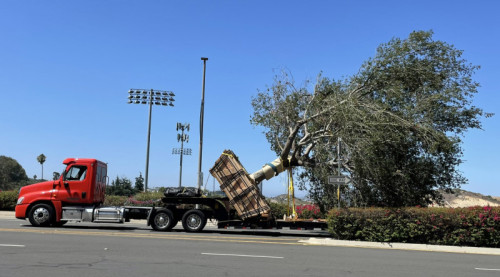
- Alumna Comes Full Circle in Return to School of EducationCassiopeia Guthrie has worn many hats in her career – educator, journalist, curriculum designer and arts advocate. But at the heart of it all is a deep commitment to equity, creativity and student success. A proud alumna of Cal State San Marcos and its School of Education, Guthrie serves as a Distinguished Teacher in Residence (DTiR) – a unique program that brings experienced educators into the university to teach, mentor and lead. DTiRs play a vital role in preparing the next generation of teachers by bridging theory and practice, offering students real-world insights and guidance rooted in classroom experience. In her role, Guthrie designs and teaches a wide range of undergraduate, credential and graduate-level courses. Her leadership extends beyond instruction, as she co-chairs the school’s Community Governance and DTiR committees and serves on the Education Recruitment Committee. “It has been an honor to come full circle by returning to teach in the School of Education," Guthrie said. “The faculty at CSUSM do an incredible job of preparing and inspiring future educators to create meaningful learning environments across our region. The opportunity to bring my classroom and real-world experience back to support our TK–12 candidates fills me with both joy and a deep sense of purpose.” Last year, Guthrie was honored with the College of Education, Health and Human Services Outstanding Alumni Award, a recognition of her impact on education and her continued dedication to CSUSM’s mission. Now, she’s taking on a new challenge as the faculty fellow for Project R.I.S.E. (Recruiting Inclusive, Supportive Educators), leading strategic programming and planning to support sustained outreach across partner school districts. Her work will lay the foundation for a future Project R.I.S.E. Center, envisioned as a regional hub to strengthen recruitment and pipeline development for aspiring educators. “Cassiopeia brings a unique blend of creativity, strategic thinking and heart to everything she does,” said Moses Ochanji, director of the School of Education. “Her leadership in Project R.I.S.E. will help us build lasting partnerships and expand opportunities for future teachers.” Guthrie’s journey began with a bachelor’s degree in journalism from San Diego State, followed by a teaching credential at CSUSM and an MBA from a private university. She is pursuing a Doctor of Education in Educational Leadership through the joint doctoral program between CSUSM and UC San Diego, with a research focus on how political rhetoric affects teachers’ emotional responses in polarized times. Her resume includes roles such as a curriculum and educational technology specialist, marketing communications officer, and arts integration fellow with CSUSM’s Center ARTES. She also has served as a journalist and theater critic, earning multiple San Diego Press Club awards and contributing to outlets such as San Diego Magazine and San Diego Story. Whether she’s leading professional development, designing equity-focused curriculum or mentoring future educators, Guthrie’s work reflects CSUSM’s commitment to innovation and developing creative solutions in partnership with the community. Support leaders like Cassiopeia Guthrie and programs like DTiR, Project R.I.S.E. and Center ARTES by contributing to CSUSM’s “Blueprint for the Future” fundraising campaign. Your gift helps us innovate in education, accelerate student success and cultivate lasting impact across our region. Learn more and give today. Media Contact Brian Hiro, Communications Specialist bhiro@csusm.edu | Office: 760-750-7306
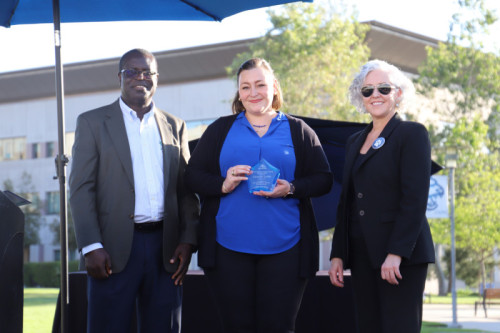
- $2 Million Grant to Benefit Chemistry and Biochemistry StudentsThe STEM field is a continuously growing community with many job opportunities available for science students. Cal State San Marcos is committed to providing the resources and support these students need to pursue higher education and integrate themselves into the workforce. That commitment received a boost recently, as CSUSM was awarded a $2 million grant from the National Science Foundation to create a learning community for chemistry and biochemistry majors and award scholarships to qualified students. The program will incorporate a Vertical Mentoring Learning Community (VMLC) for up to 30 chemistry and biochemistry students each year, with eight first-year students receiving a renewable $15,000 scholarship based on financial need. The program is led by chemistry and biochemistry professor Robert Iafe, the principal investigator, and co-principal investigators Afra Panahi, a chemistry and biochemistry professor, and Aswad Allen, CSUSM’s chief diversity officer. Together, they plan to create a community of high-achieving, motivated students recruited from introductory chemistry classes. Students who prove proficient and committed to their studies will be invited to join the learning community, and those who qualify financially will be able to apply for the additional scholarship to help with tuition and housing. “The community aspect of it gives it a supportive place to really go for your goals, but also a safe and secure place to experiment,” Iafe said. Students selected for the VMLC also will receive priority enrollment for chemistry classes and labs required for their major. The vertical mentoring learning experience highlights a discipline-specific learning community of students supported by each other, faculty members and professionals. This offers students a comfortable learning environment filled with like-minded individuals guiding them toward their futures in STEM, whether that be graduate school or pursuing a career. “We make sure they participate in professional development activities so they can build a strong science identity and become more competitive for graduate school and the job market,” Panahi said. “The supportive environment from their peer mentors, academic advisers and professional mentors can really help them build a stronger network.” The smaller, more intimate setting of the vertical mentoring program provides a comfortable space for students to ask questions freely and create a closer relationship with faculty. This environment creates a rewarding experience for all and promotes a sense of happiness and job satisfaction among the faculty involved. “There are concrete benchmarks along the way for students to actually see themselves progressing,” Allen said. "Vertical learning allows students to visualize their futures and see themselves where they want to be. “We're going to create the right atmosphere, the right environment and all the right ingredients for them to thrive.” Learn more on the Vertical Mentoring Learning Community website. Media Contact Eric Breier, Interim Assistant Director of Editorial and External Affairs ebreier@csusm.edu | Office: 760-750-7314
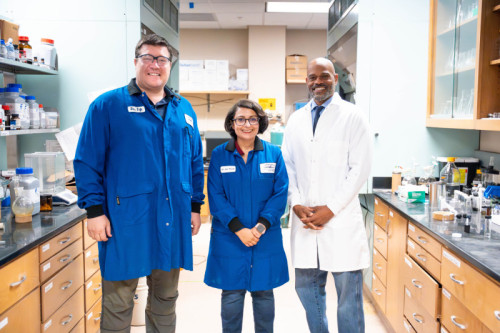
- New Library Exhibit Explores World of ZinesIt’s fitting that the title of the new art exhibit on the third floor of Kellogg Library is “Zine Dreams.” April Ibarra Siqueiros, the curator of the exhibit and a user experience librarian at Cal State San Marcos, does indeed dream of zines – short for “magazine,” the term refers to handmade publications in booklet form about any topic, presented as an alternative to mainstream media. Siqueiros dreams about the zines she wants to make. She dreams about the zines she wants to add to her growing collection. And she dreams about the zine community that she wants to cultivate at CSUSM. Her current exhibit in the library – part of the biannual Context Exhibit Series, it’s on display in person or online through Dec. 15 – is a big step in that direction. Subtitled “publishing in your hands,” the exhibit is essentially a love letter to zine culture told through Siqueiros’ creative eye and curious mind. It features about 60 zines from her personal collection – covering such topics as borders, immigration, art, gender and sexuality – and a dozen more that she has made, either by herself or with a group. It also includes information about the process of zine-making, the history of zines and the local zine community. “Zines can be a way for marginalized and oppressed voices to use a format to share their stories, make calls to action, teach something and build community,” Siqueiros said. “They can also be random, silly and made to bring joy. It's a format that is open to all, regardless of skill level. “Sometimes I hear someone say they aren't an artist or ‘creative’ when it comes to zine making, but in my experience teaching zine workshops, that doesn't matter. If someone intentionally explores zine making, it is likely a cool zine will come out of it.” Growing up in the South Bay, Siqueiros says she was always a crafty child. She remembers first hearing about zines from a Nickelodeon cartoon in the early 2000s, and she bought her first one in 2008 – a Mexican cookzine called “Vegan de Guadalupe” (a play on veganism and the Virgin Mary), it’s included in the exhibit. Siqueiros crossed over from simply collecting zines to making them about a decade ago when she was pursuing a master’s degree in library and information science at the Pratt Institute in New York. Inspired by attending the Brooklyn Zine Fest, she created her initial zine as part of an art collective with some friends. A year later, she displayed her first solo zine at the same festival. “Having been an artist and crafter, I’ve always gravitated to making things,” she said. “Zines opened up another realm of creating for me, which stuck 10 years later.” Most of zines Siqueiros has made fall under the general theme she conjured up called “Valley of Paradox.” Of those, she’s proudest of one named “Celestial Hearts: deep connections with deep space,” which is about her love of astronomy. It represented a leap forward for her in ambition, creativity and research, and about half of it is contributed content from fellow zinesters who responded to a call for submission. She’s working on a second and third part of the series, which will focus alternately on her personal astronomical adventures and stories, and research about astronomers and space explorers. Siqueiros has worked for the CSUSM library since 2019, and during that time she gradually has become exposed to an interest in zines by the campus community – whether it’s professors incorporating zines into their assignments or colleagues who make them or are just intrigued by them. She began thinking about curating the exhibit two years ago, and her desire to pursue it was reinforced as she taught zine workshops for a few instructors, including Dominque Harrison, who works for the Office of Institutional Planning & Analysis but also teaches a seminar for first-year students. Three zines created during Harrison’s class last summer are on display in the exhibit. “While zines are not mainstream, it just takes a zine point person to open up this format to someone’s world,” Siqueiros said. She would like to be that person for any number of students who stroll by her exhibit this semester. But she doesn’t want “Zine Dreams” to be only a passive experience. The goal is to unlock others’ zine-making potential. On Oct. 9 from 1-2 p.m., Siqueiros will collaborate with the Common Read program on a workshop in The Makery where students can create a page in a collective zine that highlights their identities and stories. “It might take someone years later to make one like it did for me,” she said. “Minimally, my hope is that anyone who sees the exhibit reflects on the power of DIY publishing and how zines provide a way for us to learn about things that we may never be exposed to otherwise.” Media Contact Brian Hiro, Communications Specialist bhiro@csusm.edu | Office: 760-750-7306
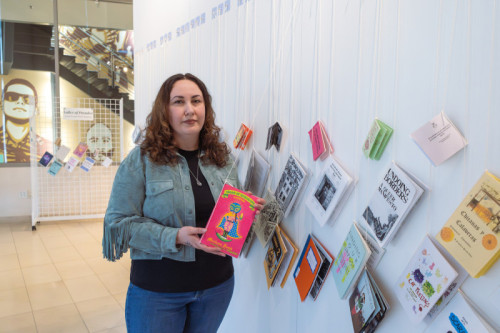
Load more...
Loading...


